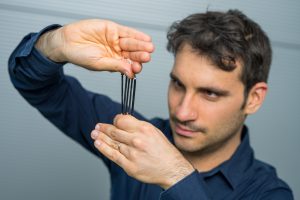
New elastomers pave the way for smarter robotic arms
Canadian Plastics
Materials Research & Development Robots & AutomationThe intelligent polymers created by researchers at Saarland University enable novel, soft robotic tools that are lighter, more agile, and more flexible than today's rigid technical components.

Junior Professor Gianluca Rizzello with “dielectric elastomers.” Photo Credit: Oliver Dietze/Saarland University
In a development that could further expand the capabilities of manufacturing robots, a research team from Saarland University, Saarbrücken, Germany, is working on a new, smart type of robot arm based on smart polymers at the Saarbrücken Center for Mechatronics and Automation Technology (Zema).
According to the researchers – who are led by Professor Stefan Seelecke and Junior Professor Gianluca Rizzello – the technology combines strong “muscles” and sensitive “nerves” created from smart polymeric materials.
“Our technology is based on smart polymer systems and enables us to create novel soft robotic tools that are lighter, more manoeuvrable and more flexible than the rigid components in use today,” Seelecke said. “An accidental shove from one of these robotic arms of the future would be more like being pushed by a human co-worker, and less likely to land you in hospital.”
The material used for these new soft robot arms is a special kind of polymer known as a “dielectric elastomer.” The Saarbrücken researchers are using this composite material to create artificial muscles and nerves. The special properties of dielectric elastomers make it possible to develop systems inspired by the ingenious designs found in nature, Seelecke said – these elastomers can be compressed, but can then be stretched to regain their original shape. “We print electrodes onto both sides of the elastomer material,” Rizzello explained. “When we apply a voltage, the two electrodes attract each other, compressing the polymer and causing it to expand out sideways.”
Which means that the elastomer can be made to contract and relax, just like muscle tissue. “We exploit this property when designing our actuators,” Rizzello said. “By precisely varying the electric field, we can make the elastomer execute high-frequency vibrations or continuously variable flexing motions or even remain still in a particular desired intermediate position.”
The researchers then combine a large number of these small “muscles” to create a flexible robot arm. When combined in this way to form a robot tentacle, the interplay between the muscles produces motions that mimic those of an octopus arm that can twist and turn in all directions. Unlike the heavy, rigid robotic limbs currently in use – which, like humans, can only execute motions in certain directions – these new robot tentacles are free to move in almost any direction. The team hopes to have the tentacle prototype fully developed in about a year’s time.
When it comes to imparting intelligence into polymeric materials, Rizzello is something of an expert. He provides the control unit – i.e. the robot’s “brain” – with the input needed to move the arm in an intelligent manner, which is a highly complex and ambitious task. “These systems are significantly more complex than the robot arms in use today,” Rizzello said. “Using artificial intelligence to control polymer-based components is substantially more challenging than controlling conventional mechatronic systems: as the elastomer muscles also have sensor properties, they can act as the system’s nerves, which means that the robot arm doesn’t need to be equipped with additional sensors. Every distortion of the elastomer, every change in its geometry causes a change in the material’s capacitance, which enables the team to assign a precise electrical capacitance value to any specific deformation of the elastomer. By measuring the capacitance, we know exactly what shape the elastomer has adopted, which allows us to extract sensor data.”
This quantitative data can then be used to precisely model and program the motion of the elastomer arm. The focus of Rizzello’s research work is on developing intelligent algorithms that can train these novel robot tentacles to move and respond in the required manner. “We are attempting to uncover which physical properties are responsible for the behaviour of these polymers,” Rizzello said. “The more we know, the more precisely we can design the algorithms to control the elastomer muscles.”
The technology being developed in Saarland will be scalable – it can be used to create miniature tentacles for medical instruments or to make large robot arms for industrial applications. But unlike the heavy robot arms in use today, the researchers say, the robot limbs built from smart elastomers will be far lighter. “Our robot arms don’t need to be driven by motors or by hydraulic or pneumatic systems – they can be powered simply by the application of an electric current,” Seelecke said. “The elastomer muscles can also be produced in shapes that meet the requirements of a particular application. And they consume very little electric power. Depending on the capacitance, the electric currents that flow are in the microampere range. This type of soft robot technology has huge promise for the future as it’s both energy efficient and cost-effective to manufacture.”
The research is supported by the German Research Foundation through the Priority Programme SPP2100 “Soft Material Robotic Systems.”
